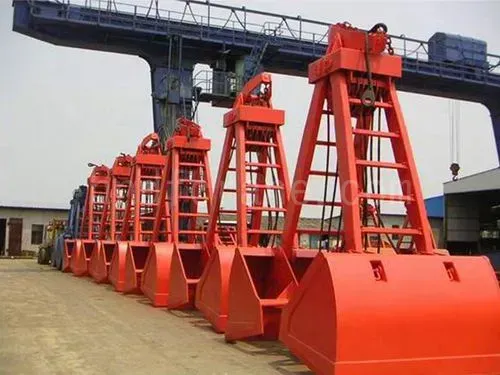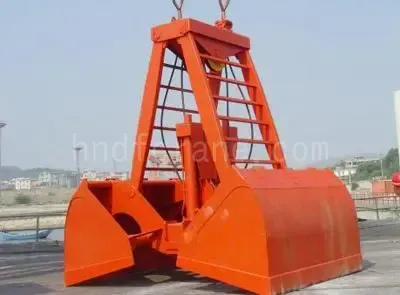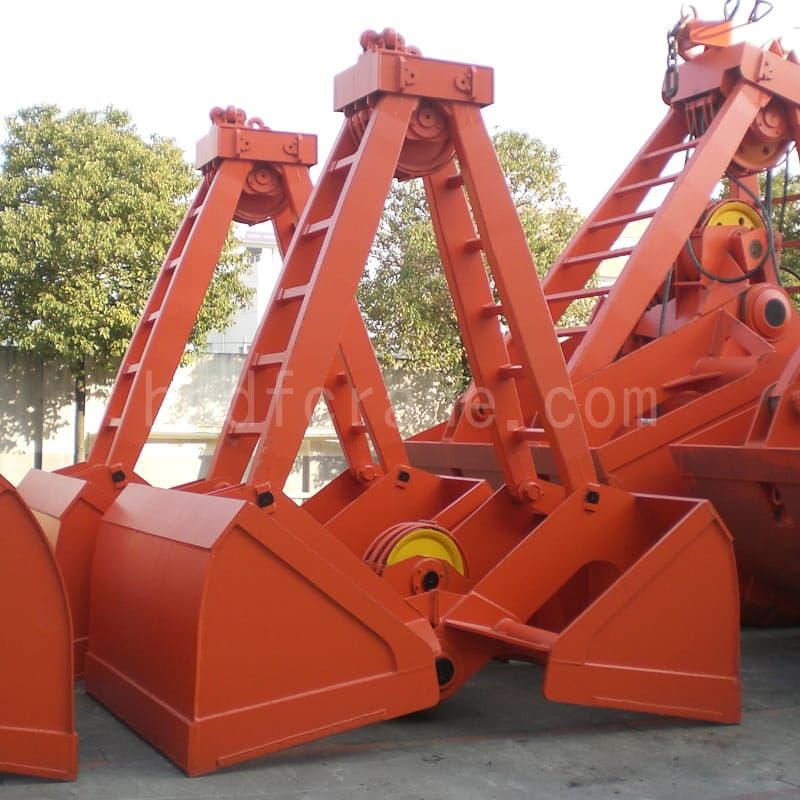Presentación del producto de las pinzas mecánicas de dos cuerdas con forma de concha
La pinza mecánica de dos cables es adecuada para todo tipo de grúas con estructura de dispositivo de elevación doble y se utiliza principalmente en puertos, muelles, construcción de carreteras y puentes y otras industrias.
Según las características del material, se puede equipar con peso ligero, medio, pesado y superpesado. Adecuado para agarrar todo tipo de acumulaciones sueltas.
Luego, se utilizan varias grúas. Equipadas con dos juegos de carretes de motor (es decir, polipastos eléctricos), cada juego de carretes conduce a un cable de acero, uno de los cuales sirve como soporte en el marco de equilibrio de la cuchara, y el otro cable de acero pasa a través de las poleas de las vigas superior e inferior para formar un bloque de poleas, que desempeña un papel en la apertura.
Las pinzas mecánicas de dos cuerdas son una herramienta eficaz para cargar y descargar cargas a granel, como arena amarilla, carbón, polvo de mineral y fertilizantes a granel en diversos entornos hostiles.
Las pinzas mecánicas de dos cuerdas tienen una estructura simple, un mecanismo de apertura y cierre novedoso, son fáciles de operar y pueden completar con precisión las acciones de apertura y cierre en varios estados.
Las pinzas mecánicas de dos cuerdas con forma de almeja adoptan un diseño virtual tridimensional y se utiliza el software ANSYS para el análisis y verificación de la resistencia. La distribución del peso es más razonable y la vida útil es más larga.
La viga de apoyo superior de las pinzas mecánicas de dos cables tipo almeja está equipada con orejetas, que se pueden conectar directamente al grillete del cable de elevación de la grúa.
Parámetros técnicos de las pinzas mecánicas de dos cuerdas

| Tipo y tamaño | Volumen(metro3) | Peso muerto) | Dimensiones (mm) | Diámetro de la polea.(mm) | Utilice la altura(metro) | Diámetro de la cuerda de acero.(mm) | Límite de estabilidad laboral(No) | ||||
| A | B | do | D | mi | |||||||
| BS3[1.2]1.3A | 1.2(300) | 1.4(4) | 1900 | 2537 | 2488 | 2841 | 1200 | ø400 | 9 | ø17,5 | 3 |
| BS3[1.6]1.4A | 1.6(300) | 1.4(4) | 2100 | 2631 | 2559 | 3040 | 1300 | ø400 | 9.5 | ø17,5 | 3 |
| BS5[1.5]2A | 1.5(350) | 2(3) | 2000 | 2659 | 2667 | 3075 | 1260 | Ø445 | 8.5 | ø19,5 | 5 |
| 2(4) | 9.8 | ||||||||||
| BS5[2]2A | 2(350) | 2(4) | 2100 | 2778 | 2818 | 3248 | 1400 | Ø445 | 10 | ø19,5 | 5 |
| BS5[2.5]2A | 2.5(350) | 2(3) | 2100 | 2787 | 2715 | 3091 | 1600 | Ø445 | 8.5 | ø19,5 | 5 |
| BS5[3]2A | 3(400) | 2(3) | 2300 | 3130 | 2938 | 3362 | 1650 | Ø445 | 9 | ø19,5 | 5 |
| BS8[2.6]3.2A | 2.6(300) | 2.6(4) | 2300 | 3038 | 3257 | 3736 | 1800 | ø560 | 11 | ø26 | 8 |
| BS8[3]3.3A | 3(300) | 3.3(4) | 2380 | 3118 | 3287 | 3786 | 1900 | ø560 | 11.5 | ø26 | 8 |
| BS8[3.8]3.5A | 3.8(300) | 3.5(4) | 2550 | 3536 | 3286 | 3733 | 2000 | ø560 | 12 | ø26 | 8 |
| BS8[4.5]3.8A | 4.5(300) | 3.8(3) | 2500 | 3505 | 3503 | 3975 | 2300 | ø560 | 12 | ø26 | 8 |
| BS10[3]4A | 3(300) | 4(4) | 2380 | 3118 | 3287 | 3786 | 1900 | ø560 | 11.5 | Ø28 | 10 |
| BS10[5]4A | 5(350) | 4(4) | 2615 | 3605 | 3503 | 3975 | 2400 | ø560 | 12 | Ø28 | 10 |
| BS10[6]4A | 6(400) | 4(4) | 2800 | 3814 | 3758 | 4290 | 2150 | ø560 | 12.5 | Ø28 | 10 |
| BS16[3.6]6A | 3.6(300) | 6(5) | 2500 | 3313 | 3810 | 4206 | 2100 | ø720 | 13.5 | ø32 | 16 |
| BS16[4]6A | 4(350) | 6(5) | 2500 | 3313 | 3810 | 4206 | 2200 | ø720 | 13.5 | ø32 | 16 |
| BS16[6]6A | 6(350) | 6(4) | 2900 | 3800 | 4249 | 4612 | 2400 | ø720 | 13.5 | ø32 | 16 |
| BS16[10]6A | 10(400) | 6 (3) | 3200 | 4000 | 3938 | 4673 | 2500 | ø650 | 12 | Ø28 | 16 |
Cómo elegir la garra adecuada
- Aclare su propósito:
Antes de profundizar en las opciones, aclare sus requisitos específicos. Pregúntese:
- ¿Qué materiales desea tratar? (Troncos, chatarra, piedra, etc.)
- ¿Qué tareas realizará la cuchara? (Carga, clasificación, desmontaje, etc.)
- ¿A qué tipo de dispositivo se conectará? (Grúa pórtico, grúa aérea)
- ¿Cuál es la gravedad específica del material que agarras? ¿El número de cubos del agarre?
¿Cuál es el tonelaje de su grúa equipada con pinza?
Según las características del material a agarrar, la pinza suele dividirse en cuatro tipos básicos: ligera, media, pesada y superpesada.
| El tipo de material a agarrar | Material de agarre | Capacidad de peso (t/m³) |
| Luz | Coque, escorias, cereales, patatas, cal antracita de calidad media, cemento, tierra, grava, arcilla, ladrillos rotos, etc. | 0.5~1.2 |
| Medio | Turba, grandes trozos de carbón antracita, carbón compactado, arcilla, caliza, grava, sal, grava, ladrillos, bauxita, copos de óxido de hierro, cemento, arena y ladrillos en agua, etc. | 1.2~2.0 |
| Pesado | Caliza, arcilla pesada, minerales de tamaño pequeño y mediano, roca dura, óxido de hierro en forma de varilla, mineral de hierro, polvo de concentrado de plomo, etc. | 2.0~2.6 |
| Sobrepeso | Minerales de gran tamaño, minerales de manganeso de gran tamaño, polvo de mineral de plomo aglomerado sedimentario, etc. | 2.6~3.3 |
- Compatibilidad de accesorios: Asegúrese de que la pinza sea compatible con el equipo existente.
- Consideraciones presupuestarias: El rango de precios de la pinza es diferente. Equilibre su presupuesto en función de la función y la durabilidad de la pinza.
- Comentarios y sugerencias: Investigue en línea, lea reseñas de usuarios y busque sugerencias de colegas de la industria.
- Acuda al fabricante de la grúa para realizar una inspección y prueba en el lugar antes de comprar: Pruebe la pinza en condiciones reales tanto como sea posible. Evalúe su rendimiento, facilidad de uso y funcionalidad general.
Tenga en cuenta que elegir la pinza adecuada requiere un equilibrio entre funcionalidad, seguridad y costo. Al considerar estos factores,



















































































